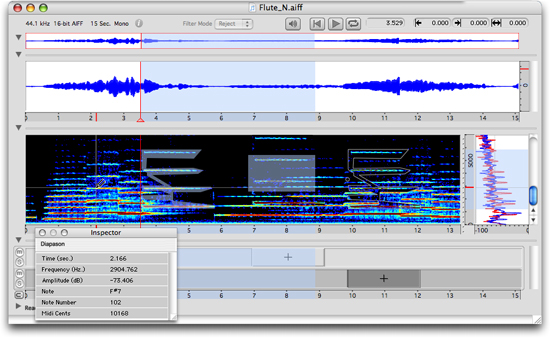Chapter One: An Acoustics Primer

8. What are wave shapes and spectral content? | Page 4
Composers have been able to graphically get inside spectral analyses of a wave stream to manipulate the pitch, timing and evolving amplitudes of individual partials with very interesting results — made easy by programs such as Audiosculpt (IRCAM) and SPEAR (Klingbeil), and even Adobe Audition.

IRCAM Audiosculpt main display
A related process called phase vocoding (PV) allows successive spectral analysis snapshots to be “resynthesized” by creating a sine wave for each partial (or band), which follows the original analysis. PV theory will be discussed in greater detail later in this text. Developed in the 1960's, but later refined by Mark Dolson et al. in the late 1990's, the beauty is that a sound can be “reconstituted” at any desired speed, forward or backward or even stopped at a moment in time, without altering its pitch, as would be the case if a tape were sped up or slowed down. A sound can also be altered in pitch without altering the time domain, as it would be if using magnetic tape or other forms of digital speed alteration. The phase vocoding technique exemplifies a type of synthesis by analysis. The ubiquitous Auto-Tune technology utilizes a shortcut variant of the principle of phase vocoding, for better or worse.
For a detailed discussion of the spectra created by specific synthetic waveforms typically found on synthesizers (such as triangle waves, square waves, etc.), visit Chapter Four: Synthesis: Waveforms.
In the real acoustic world, many different frequencies dynamically combine, either from the same source or from different sources, to create our impression of timbre. It should be noted that the summation of waveforms creates a series of complex interactions over time. However, at any instantaneous moment in time, only one sound pressure level is acting upon our eardrum and only one voltage is being applied to a loudspeaker, even if you are listening to or reproducing an orchestra of 80 instruments. We perceive the mixture of pitches through the complexities of a varying pressure stream and also a bit of psychoacoustic extrapolation on our part (the 19th Century “father of acoustics” Helmholtz believed that our perceiving the musical pitch of a sound was dependent on the presence of its fundamental sine wave — this has now been proven to not always be the case).